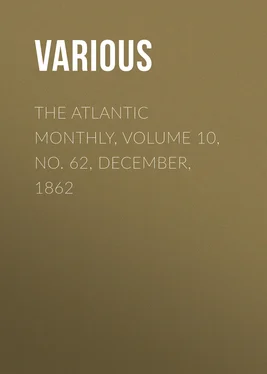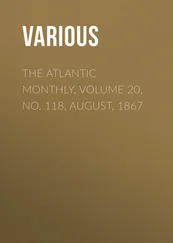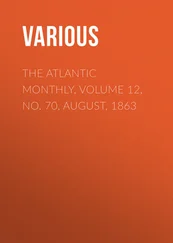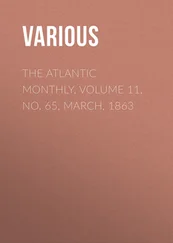Various - The Atlantic Monthly, Volume 10, No. 62, December, 1862
Здесь есть возможность читать онлайн «Various - The Atlantic Monthly, Volume 10, No. 62, December, 1862» — ознакомительный отрывок электронной книги совершенно бесплатно, а после прочтения отрывка купить полную версию. В некоторых случаях можно слушать аудио, скачать через торрент в формате fb2 и присутствует краткое содержание. Жанр: foreign_antique, periodic, foreign_edu, на английском языке. Описание произведения, (предисловие) а так же отзывы посетителей доступны на портале библиотеки ЛибКат.
- Название:The Atlantic Monthly, Volume 10, No. 62, December, 1862
- Автор:
- Жанр:
- Год:неизвестен
- ISBN:нет данных
- Рейтинг книги:4 / 5. Голосов: 1
-
Избранное:Добавить в избранное
- Отзывы:
-
Ваша оценка:
- 80
- 1
- 2
- 3
- 4
- 5
The Atlantic Monthly, Volume 10, No. 62, December, 1862: краткое содержание, описание и аннотация
Предлагаем к чтению аннотацию, описание, краткое содержание или предисловие (зависит от того, что написал сам автор книги «The Atlantic Monthly, Volume 10, No. 62, December, 1862»). Если вы не нашли необходимую информацию о книге — напишите в комментариях, мы постараемся отыскать её.
The Atlantic Monthly, Volume 10, No. 62, December, 1862 — читать онлайн ознакомительный отрывок
Ниже представлен текст книги, разбитый по страницам. Система сохранения места последней прочитанной страницы, позволяет с удобством читать онлайн бесплатно книгу «The Atlantic Monthly, Volume 10, No. 62, December, 1862», без необходимости каждый раз заново искать на чём Вы остановились. Поставьте закладку, и сможете в любой момент перейти на страницу, на которой закончили чтение.
Интервал:
Закладка:
In Europe, the earliest evidences of man disclosed by our investigations are even more vague and shadowy. Probably, without antedating in time these historical records of Asia, they reach back to a more primitive and barbarous era. The earliest history of Europe is not studied from inscription or manuscript or even monument; it is not, like the Asiatic, a conscious work of a people leaving a memorial of itself to a future age. It is rather, like the geological history, an unconscious, gradual deposit left by the remains of extinct and unknown races in the soil of the fields or under the sediment of the waters. The earliest European barbarian, as he burned his canoe from a log, or fabricated his necklace from a bone, or worked out his knife from a flint, was in reality writing a history of his race for distant days. We can follow him now in his wanderings through the rivers and lakes and on the edges of the forests; we open his simple mounds of burial, and study his barbarian tools and ornaments; we discover that he knew nothing of metals, and that bone and flint and amber and coal were his materials; we trace out his remarkable defences and huts built on piles in the various lakes of Europe, where the simple savage could escape the few gigantic "fossil" animals which even then survived, and roved through the forests of Prussia and France, or the still more terrible human enemies who were continually pouring into Germany, Denmark, and Switzerland from the Asiatic plains. We find that the early savage of Switzerland and Sweden was not entirely ignorant of the care of animals, and that he had fabricated some rude pottery. Of what race he was, or when he appeared amid the forests of Northern Europe, no one can confidently say. Collecting the various indications from the superstitions, language, and habits of this barbarian people, and comparing them with like peculiarities of the most ancient races now existing in Europe, we can frame a very plausible hypothesis that these early savages belonged to that great family of which the Finns and Laps, and possibly the Basques, are scattered members. Their skulls, also, are analogous in form to those of the Finnish race. This age the archaeologists have denominated the "Stone Age" of European antiquity.
Following this is what has been called by them the "Bronze Age." Another, more powerful, and more cultivated race or collection of peoples inundates Scandinavia, Germany, Switzerland, and other districts. They make war against and destroy the early barbarians; they burn their water-huts, and force them to the mountains, or to the most northern portions of the continent. This new race has a taste for objects of beauty. They work copper and bronze; they make use of beautiful vases of earthenware and ornaments of the precious metals; but they have yet no knowledge of iron or steel. Their dead are burned instead of being buried, as was done by the preceding races. They are evidently more warlike and more advanced than the Finnish barbarians. Of their race or family it is difficult to say anything trustworthy. Their skulls belong to the "long-skulled" races, and would ally them to the Kelts. Antiquaries have called their remains "Keltic remains."
Still another age in this ancient history is the "Iron Age," when the tribes of Europe used iron weapons and implements, and had advanced from the nomadic condition to that of cultivators of the ground, though still gaining most of their livelihood from fishing and hunting. This period no doubt approached the period of historical annals, and the iron men may have been the earliest Teutons of the North,—our own forefathers; but of their race or mixture of races we have no certain evidence, and can only make approximate hypotheses,—the division of "ages" by archaeologists, it should be remembered, being not in any way a fixed division of races, but only indicating the probability of different races at those different early periods. What was the date of these ages cannot at all be determined; the earlier are long before any recorded European annals, but there is no reason to believe that they approach in antiquity the Asiatic records and remains.
Such, until recently, were the historic and scientific evidences with regard to the antiquity of man. His most venerable records, his most ancient dates of historic chronology were but of yesterday, when compared with the age of existing species of plants and animals, or with the opening of the present geologic era. Every new scientific investigation seemed, from its negative evidence, to render more improbable the existence of the "fossil man." It is true that in various parts of the world, during the past few years, human bones have been discovered in connection with the bones of the fossil mammalia; but they were generally found in caves or in lime-deposits, where they might have been dropped or swept in by currents of water, or inserted in more modern periods, and yet covered with the same deposit as the more ancient relics. Geologists have uniformly reasoned on the a priori improbability of these being fossil bones, and have somewhat strained the evidence—as some distinguished savans 2 2 Pictet.
now believe—against the theory of a great human antiquity.
And yet the "negative evidence" against the existence of the fossil man was open to many doubts. The records of geology are notoriously imperfect. We probably read but a few leaves of a mighty library of volumes. Moreover, the last ages preceding the present period were witnesses of a series of changes and slowly acting agencies of destruction, from which man may have in general escaped. We have reason to believe that during long periods of time the land was gradually elevated and subject to oscillations, so that the courses of rivers and the beds of lakes were disturbed, and even the bottom of the ocean was raised. The results were the inundation of some countries, and the pouring of great currents of water over others, wearing down the hills and depositing in the course of ages the regular layers of gravel, sand, and marl, which now cover so large a part of Europe. This was still further followed by a period in which the temperature of the earth was lowered, and ice and glaciers had perhaps a part in forming the present surface of the northern hemisphere. During the first period, which may be called the "Quaternary Period," 3 3 We should bear in mind that the Quaternary or Diluvian Period, however ancient in point of time, has no clearly distinguishing line of separation from the present period. The great difference lies in the extinction of certain species of animals, which lived then, whose destruction may be due both to gradual changes of climate and to man.—PICTET.
the mighty animals lived whose bones are now found in caverns, or under the slowly deposited sediment of the waters, or preserved in bog,—the mammoth, and rhinoceros, and elk, and bear, and elephant, as well as many others of extinct species.
We may suppose, that, if man did exist during these convulsions and inundations, his superior intelligence would enable him to escape the fate of the animals that were submerged,—or that, if his few burial-places were invaded by the waters, his remains are now completely covered by marine deposits under the ocean. If, however, in his barbarian condition, he had fashioned implements of any hard material, and especially if, as do the savages of the present family of man, he had accidentally deposited them, or had buried them with the dead in mighty mounds, the invading waters might well sweep them together from their place and deposit them almost in mass, in situations where the eddies should leave their gravel and sand. 4 4 Sir C. Lyell, in his remarks before the British Association in 1859, said upon the discovery alluded to here: "I am reminded of a large Indian mound which I saw in St. Simon's Island in Georgia,—a mound ten acres in area, and having an average height of five feet, chiefly composed of cast-away oyster-shells, throughout which arrow-heads, stone axes, and Indian pottery were dispersed. If the neighboring river, the Altamalia, or the sea which is at hand, should invade, sweep away, and stratify the contents of this mound, it might produce a very analogous accumulation of human implements, unmixed, perhaps, with human bones."— Athenaeum , September 21, 1859.
Интервал:
Закладка:
Похожие книги на «The Atlantic Monthly, Volume 10, No. 62, December, 1862»
Представляем Вашему вниманию похожие книги на «The Atlantic Monthly, Volume 10, No. 62, December, 1862» списком для выбора. Мы отобрали схожую по названию и смыслу литературу в надежде предоставить читателям больше вариантов отыскать новые, интересные, ещё непрочитанные произведения.
Обсуждение, отзывы о книге «The Atlantic Monthly, Volume 10, No. 62, December, 1862» и просто собственные мнения читателей. Оставьте ваши комментарии, напишите, что Вы думаете о произведении, его смысле или главных героях. Укажите что конкретно понравилось, а что нет, и почему Вы так считаете.












